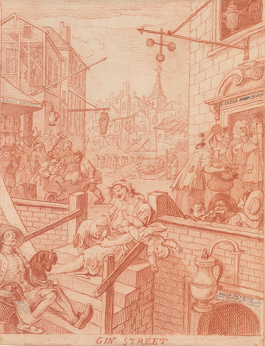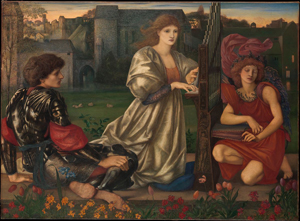A Proper English Beer
John Haberin New York City
William Hogarth and British Art at the Met
Now if only William Hogarth had meant craft beer, but no. The painter of Marriage à-la-Mode had no patience for beer à la mode. He attends to the fine dignities and indignities of a London street, with drinkers everywhere, and drives their cruelty home, at the Morgan Library.
The Brits are back, their bad habits intact. For Hogarth, they spill out over the streets and taverns of London, each with an improper serving of proper English beer. And those are the ones not drunk out of their mind on gin. Not to worry, though, for the Met has restored the nation's dignity.  Its renewed British galleries map the growth of empire through objects of privilege, beauty, and wealth. It also restores to the aristocracy its self-image and a proper cup of tea.
Its renewed British galleries map the growth of empire through objects of privilege, beauty, and wealth. It also restores to the aristocracy its self-image and a proper cup of tea.
The Met's British galleries return after a long renovation of a sleepy corner of the museum that, I must admit, I struggle to remember. And they differ strikingly from its last major expansion, the American wing, with the latter's upscale space and democratic aspirations. Forget anything like George Washington Crossing the Delaware or the Hudson River School. This is the royalty that America rebelled against. Yet it is also dazzling in its sheer pace of progress, the progress that led straight to the American Revolution and, until the Civil War and the Emancipation Proclamation, a cry for racial justice and an end to slavery that left America behind. So is it a about art or privilege?
Cruelty and progress
William Hogarth packs ever so much of eighteenth-century London into two modest series of prints, Beer Street and Gin Lane and The Four Stages of Cruelty, both from February 1751. He does it as each story unfolds, but all the more so in a single busy London street. People are everywhere, attending to their business or pleasure—crowding the tavern doors, drunk on the stairs, hauling their wares, or managing their accounts. They care as much about each, enough to have dedicated their lives to one or the other. I can almost taste the beer or the gin. Never mind that I cannot quite remember his actors or their manifold incidents.
That dedication is the substance of urban life, and Hogarth loves every minute of it. Even more, it represents a choice in a moral fable. Chugging a beer comports quite well, thank you, with gravity, if not sobriety, while a gin joint does not. It is not just that beer has less alcohol than hard liquor, at a time when almost any other source of drinking water was undrinkable. It is also proper English beer, and the artist is concerned for the character of a nation. If he were alive today, he would leave craft beer to the spoiled rich kids that he disdained.
He is often remembered for just that unvarnished view of wealth and aristocracy, but he is too conservative at heart for a republican. As a moralist, he is an equal-opportunity hater. Born in 1697, he made his mark in 1731 with A Harlot's Progress, six prints of a country girl gone bad—and, two years later, with A Rake's Progress, eight prints of a merchant's son throwing away his money on women like her. Industry and Idleness follows two apprentices as one works his way up to lord mayor, while the other descends to the gallows. The artist makes the choice at the Morgan between beer and gin all the clearer by setting scenes in parallel. An angled street in one matches a wall in another, while the cater-cornered taprooms are mirror images, right down to a weather vane in each one.
The Morgan displays its two series as "Cruelty and Humor"—but the humor has not dated nearly as well as the cruelty. One may think of Hogarth as a caricaturist, but he exaggerates acts, not facial features. The stages of cruelty begin with rough handling of fowl on its way to the market before the coarser mistreatment of animals in whipping and sodomy. Another poor little rich boy enters the scene, and at his death an autopsy tries to determine what made him a murderer. The stout moralists in their proper wigs and fine clothes add that final cruelty of their own. Hogarth himself dwells on cruelty, and the hypocrisy leaves a bitter note in a bitter picture, but it also adds a saving irony.
One might make a different mistake than I did about the beer. From the first series title, one might expect a stern lecture on abstinence and his nation's chosen drinks. The artist, though, really does relish activity, whether industry or pleasure. The pairing and human detail may sound like Eden and hell for Hieronymus Bosch or Pieter Bruegel, but it can take more than a second look to tell the extremes apart. In Hogarth's paintings, the period style is unmistakably English, after Thomas Gainsborough. Yet many historians stress its debt to the excess and indulgence of Jean Antoine Watteau, Jean Honoré Fragonard, and Rococo France.
The show includes a self-portrait from the Yale Center for British Art along with prints and preparatory sketches, several from the Morgan's unparalleled collection. The portrait's brushwork sure looks like Gainsborough's, but its haste derives from Hogarth's work habits as well. On paper, he constructs his figures from tight coils of red chalk, like Tintoretto but denser, with an occasional addition in pen. And then he is all but done. The rare change on the way to a print prunes back his overworked imagination, to focus more clearly on the moral choices. For the artist as for the future mayor, industry is not the same as patience.
A proper cup of tea
The Met fills ten tightly knit rooms with more than seven hundred works of decorative art. A circle of tall glass cabinets has space for more than a hundred tea sets alone. The new British galleries begin with a positive assault on the senses, in Chinese porcelain and late Renaissance Italian sculpture, English tapestry and fine wood walls, clockworks and porcelain, fine silver and even finer plates. They open onto grand stairs that one can now ascend, from a mansion well north of London's poverty and drunken frenzy, feeling oneself privileged. Reduced lighting recalls a time before electricity, but also the hush of greatness. Portraits by Joshua Reynolds, George Romney, Peter Lely, and Gainsborough recall the class that might have deigned to visit.
They also tell a story, nestled between the galleries for medieval and American art. They start with a small sample of medieval art from England, in fine alabaster carvings, and they end with a Gothic revival, including a large sideboard. England, they say, emerged from the Middle Ages under Elizabeth I and the Tudor dynasty by incorporating the East India Company and founding an empire.  They also end under a second Queen Elizabeth, with a grand exhibition of the decorative arts, at the Crystal Palace in London in 1851. An early nineteenth-century portrait by William Beechy shows the prince regent as an officer with a youthful composure and a truly awful shock of gray hair. By then, it appears, England could afford a display of power and ease.
They also end under a second Queen Elizabeth, with a grand exhibition of the decorative arts, at the Crystal Palace in London in 1851. An early nineteenth-century portrait by William Beechy shows the prince regent as an officer with a youthful composure and a truly awful shock of gray hair. By then, it appears, England could afford a display of power and ease.
In between come centuries of turmoil, but also the Enlightenment. The curators, led by Sarah Lawrence and Wolf Burchard (a Brit!), note that such literary lions as Samuel Johnson and his Boswell gathered in coffee shops, if not served from the extravagant urns here. Remember, too, that British empiricism in philosophy began with John Locke's defense of "life, liberty, and property," with the third term inescapable. Leave the pursuit of happiness to American democracy. That property, the Met also points out, included slaves from Africa along with sugar, cocoa, and coffee from the Caribbean and tea from China. A chess set takes the shape of Indian soldiers.
Unlike the Met's American wing of 2012, the British galleries have little in the way of images of a nation, other than through its elsewhere. Unlike the American wing, an Afrofuturism period room coming up nearby, the Met's Islamic wing of the year before, the Yale Center for British Art, it also has little other than decorative art. (No jokes, please, about the limits of English paintings.) The few exceptions mostly supply a cast to oversee the splendor. A portrait of uncertain hand from around 1606 relies on awkward flattening and exquisite detail for the elder sister of the future Charles I, soon enough married off to Bohemia. One last painting, by Edward Burne-Jones, applies a Pre-Raphaelite languor to La Chanson d'Amour (or "the love song," quoting a Breton ballad), because by the 1860s art and empire alike were looking back.
While the British galleries lack the expanse of the American wing, with its dining area and the façade of a bank building, it does alternate the luxuriance of objects and the luxuriance of interiors. Beer does slip in among the first, but like nothing commoners could ever have known. Bottles take the shape of bears, with detachable heads. Tankards are immense and pure silver. By the nineteenth century, the media include majolica (or glazed earthenware) for colorful and enormous birds, one a peacock. The Brits had nailed down their trademark humor and eccentricity.
Interiors include the grand stairwell, a fireplace, and a canopy bed, but also two large foyers with simulated views onto gardens. A chandelier in one reflects off the glass doors and windows. Life-size sculpture on surrounding walls borrows from classical Rome for its style and its virtues, of stoicism and dignity. Both rooms seem all the stranger, emptier, and more precious by contrast with the sheer number of objects in surrounding rooms. You may cherish the silence—only to draw back in amazement at the intricate inlaid ceilings. On the eve of Brexit, with renovations of wings for African and modern art still to come, the reality or unreality of Great Britain today seems ever so far away.

William Hogarth ran at The Morgan Library through September 22, 2019. The British galleries reopened at The Metropolitan Museum of Art on March 2, 2020. A related review visits the Yale Center for British Art.




